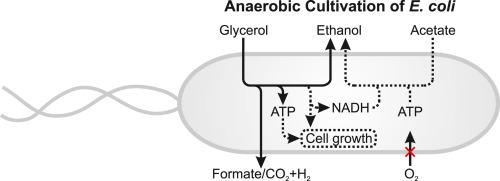Metabolic Engineering ( IF 6.8 ) Pub Date : 2022-05-28 , DOI: 10.1016/j.ymben.2022.05.006 Simon Boecker 1 , Sebastián Espinel-Ríos 1 , Katja Bettenbrock 1 , Steffen Klamt 1

|
Glycerol has become an attractive substrate for bio-based production processes. However, Escherichia coli, an established production organism in the biotech industry, is not able to grow on glycerol under strictly anaerobic conditions in defined minimal medium due to redox imbalance. Despite extensive research efforts aiming to overcome these limitations, anaerobic growth of wild-type E. coli on glycerol always required either the addition of electron acceptors for anaerobic respiration (e.g. fumarate) or the supplementation with complex and relatively expensive additives (tryptone or yeast extract). In the present work, driven by model-based calculations, we propose and validate a novel and simple strategy to enable fermentative growth of E. coli on glycerol in defined minimal medium. We show that redox balance could be achieved by uptake of small amounts of acetate with subsequent reduction to ethanol via acetyl-CoA. Using a directed laboratory evolution approach, we were able to confirm this hypothesis and to generate an E. coli strain that shows, under anaerobic conditions with glycerol as the main substrate and acetate as co-substrate, robust growth (μ = 0.06 h−1), a high specific glycerol uptake rate (10.2 mmol/gDW/h) and an ethanol yield close to the theoretical maximum (0.92 mol per mol glycerol). Using further stoichiometric calculations, we also clarify why complex additives such as tryptone used in previous studies enable E. coli to achieve redox balance. Our results provide new biological insights regarding the fermentative metabolism of E. coli and offer new perspectives for sustainable production processes based on glycerol.
中文翻译:

使用醋酸盐作为氧化还原槽,在确定的基本培养基中实现大肠杆菌对甘油的厌氧生长
甘油已成为生物基生产工艺的有吸引力的基质。然而,由于氧化还原失衡,大肠杆菌,一种生物技术工业中成熟的生产有机体,在严格厌氧的条件下,在限定的基本培养基中不能在甘油上生长。尽管旨在克服这些限制的广泛研究努力,野生型大肠杆菌在甘油上的厌氧生长总是需要添加用于厌氧呼吸的电子受体(例如富马酸盐)或补充复杂且相对昂贵的添加剂(胰蛋白胨或酵母提取物)。在目前的工作中,在基于模型的计算的驱动下,我们提出并验证了一种新颖且简单的策略,以使大肠杆菌能够发酵生长在确定的基本培养基中使用甘油。我们表明氧化还原平衡可以通过摄取少量乙酸盐随后通过乙酰辅酶A还原为乙醇来实现。使用定向实验室进化方法,我们能够证实这一假设并产生大肠杆菌菌株,该菌株在厌氧条件下以甘油为主要底物,乙酸盐为共底物,生长强劲 ( μ = 0.06 h -1 )、高比甘油吸收率 (10.2 mmol/gDW/h) 和接近理论最大值的乙醇产率 (0.92 mol/mol 甘油)。使用进一步的化学计量计算,我们还阐明了为什么以前研究中使用的复杂添加剂(例如胰蛋白胨)能够使大肠杆菌达到氧化还原平衡。我们的研究结果为大肠杆菌的发酵代谢提供了新的生物学见解,并为基于甘油的可持续生产过程提供了新的视角。







































 京公网安备 11010802027423号
京公网安备 11010802027423号